Ditapis dengan
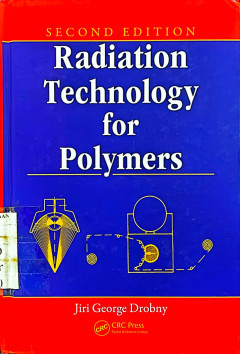
Radiation Technology for Polymers, Second Edition
With a heightened focus on green chemistry and sustainability as well as the development of nanomaterials, this second edition explores emerging applications of radiation technology to polymers. It considers novel uses in the automotive, electronics, and wood-processing industries; applications in waterborne coatings and adhesives, film modifications, high-performance coatings, and inkjet techn…
- Edisi
- Second Edition
- ISBN/ISSN
- 9781420094046
- Deskripsi Fisik
- 283 p. : illus. ; 24 cm
- Judul Seri
- -
- No. Panggil
- 668.9 DRO r
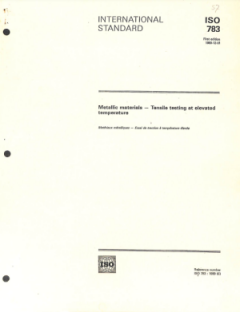
Metalica Materials-Tensile Testing at Elevated Temperature
-
- Edisi
- -
- ISBN/ISSN
- -
- Deskripsi Fisik
- -
- Judul Seri
- ISO 783-1989 (E)
- No. Panggil
- 621.3673 ISO M
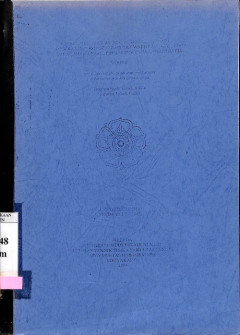
Pengaruh Iradiasi Sinar Gamma Terhadap Pengurangan Konsentrasi Zat Warna Napt…
Pada saat ini masih banyak industri batik di Yogyakarta yang masih mengolah hasil limbahnya secara kimia, namun cara ini kurang efektif karena tidak dapat mengolah limbah hasil proses pewarnaan kain batik yang mengandung zat warna sintetis yang bersifat karsinogenik dan nonbiodegadrable. Untuk itu diperlukan teknik pengolahan limbah dengan radiasi sinar gamma. Pengurangan konsentrasi zat warna …
- Edisi
- -
- ISBN/ISSN
- -
- Deskripsi Fisik
- xiv, 80 p. : Illus. ; 10 cm
- Judul Seri
- -
- No. Panggil
- 621.48 UMM p
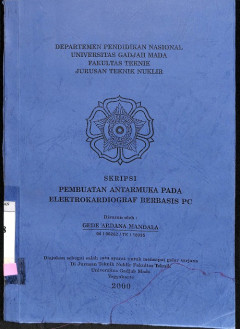
Pembuatan Antarmuka Pada Elektrokardiograf Berbasis PC
Peralatan Elektrokardiograf (EKO) merupakan peralatan yangs sangat dibutuhkan dalam suatu rumah sakit. Perlu dilakukan perancangan dan pembuatan antarmuka untuk memanfaatkan PC sebagai EKG. Perancangan dilakukan dengan mempertimbangkan ketersediaan komponen di pasaran lokal. (Jml)
- Edisi
- -
- ISBN/ISSN
- -
- Deskripsi Fisik
- xvi, 228 p. : Illus. ; 20 cm
- Judul Seri
- -
- No. Panggil
- 621.48 MAN p
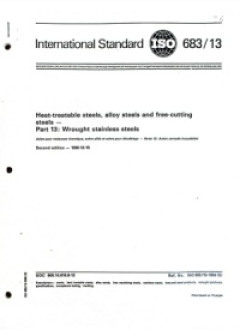
Heat-Treatable Steels, Alloys Steels and Free-Cutting Steels. Port 13: Wrough…
-
- Edisi
- -
- ISBN/ISSN
- -
- Deskripsi Fisik
- -
- Judul Seri
- ISO 683/13 - 1986 (E)
- No. Panggil
- 621.3673 ISO H
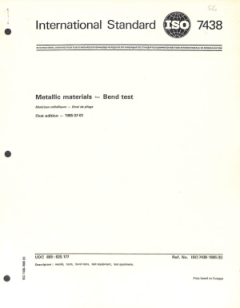
Metalic Materials-Bend Test
Specifies the method for determining the ability of metallic materials to undergo plastic deformation in bending. Applies to the bend test of test pieces taken from metallic products as specified in the relevant product standards. It is not applicable to certain materials and/or products, for example tubes in full section or welded joints, for which other standards exist.
- Edisi
- -
- ISBN/ISSN
- -
- Deskripsi Fisik
- -
- Judul Seri
- ISO 7438-1985 (E)
- No. Panggil
- 669.00212 ISO M
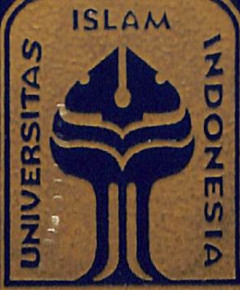
Pra Rancangan Pabrik Isopropil Palmitat Dari Isopropil Alkohol dan Asam Palmi…
Pabrik iso propil Palmitat dari iso propil alkohol dan asam palmitat dirancang dengan kapasitas 20.000 ton/tahun. Pabrik beroperasi secara kontinyu selama 330 hari. Iso propil palmitat adalah plasticizer yang dibuat dari esterifikasi iso propil alkohol dan asam palmitat dengan bantuan katalisator asam sulfat 98% di dalam reaktor Alir Tangki Berpengaduk pada suhu 130oC dan tekanan 6 atm. Reaksi …
- Edisi
- -
- ISBN/ISSN
- -
- Deskripsi Fisik
- xii, - p. : Illus. ; 62 cm
- Judul Seri
- -
- No. Panggil
- 660.2 YUN p
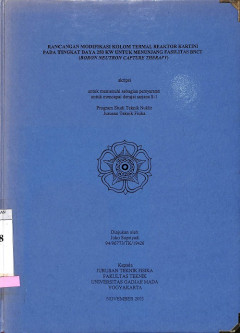
Rancangan Modifikasi Kolom Termal Reaktor Kartini Pada Tingkat Daya 250 Kw Un…
Terapi kanker dengan BNCT memerlukan fluks neutron tinggi baik termal maupun epitermal, karenanya reaktor adalah sumber yang paling layak. Namun berkas neutron dari reaktor mengandung konaminan berupa sinar gamma dan neutron cepat. Reaktor Kartini sebagai kandidat sumber neutron perlu dimodifikasi untuk menunjang fasilitas BNCT. Salah satu pilihan adalah memodifikasi kolom termal. Dalam hal ini…
- Edisi
- -
- ISBN/ISSN
- -
- Deskripsi Fisik
- xii, 72 p. : Illus. ; 13 cm
- Judul Seri
- -
- No. Panggil
- 621.48 SUP r
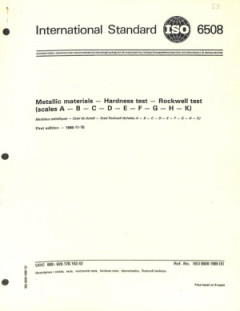
Metalic Materials-Hardness Test-Rockwell Test (Scales A-B-C-D-E-F-G-H-K)
-
- Edisi
- -
- ISBN/ISSN
- -
- Deskripsi Fisik
- -
- Judul Seri
- ISO 6508-1986 (E)
- No. Panggil
- 669.00212 ISO M
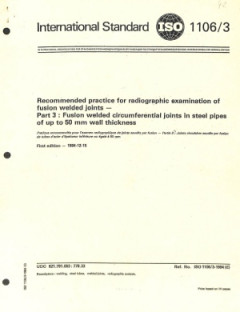
Recommended Protice For Radiographie Examination of Fusion Welded Joints - Pa…
The detection of flaws in an item submitted to X- or gamma-radiographic examination depends on the particularities of the technique employed. This part of ISO 1106 specifies general techniques of weld radiography with the object of enabling satisfactory results to be obtained economically. The techniques are based on generally accepted practice and the fundamental theory of the subject.
- Edisi
- Part 3
- ISBN/ISSN
- -
- Deskripsi Fisik
- -
- Judul Seri
- ISO 1106/3-1985 (E)
- No. Panggil
- 621.3673 ISO R
 Karya Umum
Karya Umum  Filsafat
Filsafat  Agama
Agama  Ilmu-ilmu Sosial
Ilmu-ilmu Sosial  Bahasa
Bahasa  Ilmu-ilmu Murni
Ilmu-ilmu Murni 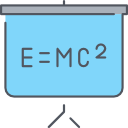 Ilmu-ilmu Terapan
Ilmu-ilmu Terapan  Kesenian, Hiburan, dan Olahraga
Kesenian, Hiburan, dan Olahraga  Kesusastraan
Kesusastraan  Geografi dan Sejarah
Geografi dan Sejarah